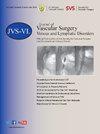一项为期三年的随机对照试验,比较大隐静脉机械化学消融后静脉曲张的伴随治疗和分期治疗。
IF 2.8
2区 医学
Q2 PERIPHERAL VASCULAR DISEASE
Journal of vascular surgery. Venous and lymphatic disorders
Pub Date : 2025-05-05
DOI:10.1016/j.jvsv.2025.102255
引用次数: 0
摘要
目的:机械化学消融治疗隐静脉功能不全是一种可行的静脉内非热、非肿胀治疗方法。1,2,3然而,隐干介入治疗静脉曲张的理想方法仍然不明确静脉曲张的治疗可以同时进行,也可以分阶段进行这项为期三年的随访研究的目的是介绍一项随机对照试验的中期结果,比较支流的伴随治疗和分期治疗。方法:2016-2017年在赫尔辛基大学医院静脉门诊就诊的单侧CEAP(临床、病因、解剖、病理生理)C2-4静脉疾病患者纳入随机对照试验。在对1149例患者进行资格评估后,85例患者符合纳入标准:年龄20-70岁,超声证实膝上大隐静脉返流,直径5-10毫米,患者书面同意,无深静脉返流,外周动脉疾病,妊娠,淋巴水肿,体重指数> 40 kg/m2,对硬化剂过敏,深静脉血栓形成史或任何形式的凝血功能障碍。参与者:按1:1的比例随机分配,如果需要,在三个月时接受分阶段的泡沫硬化治疗(1组),或同时接受静脉切除术(2组),辅助大隐静脉干的机械化学消融。所有患者都被邀请参加为期三年的随访,在此期间,最初治疗的腿部接受双工超声评估。主要观察指标为随访期间的再干预率。次要结局包括膝关节以上大隐静脉返流、患者满意度、大隐静脉状态、静脉曲张数量和随访症状。结果:随访期间,1组11.4% (n=5/44) [95% CI, 0.02 ~ 0.21], 2组4.9% (n=2/41) [95% CI, -0.02 ~ 0.11]需要额外治疗(1组vs 2组OR=2.5 [95% CI, 0.46 ~ 13.67], P=0.435)。治疗组在膝上大隐静脉反流(P=0.603)、疾病特异性和健康相关生活质量(P=0.238和P=0.255)、大隐静脉状态(P=0.112)或症状方面没有统计学上的显著差异。然而,非劣效性分析表明,分阶段方法不如伴随方法。此外,与组2相比,组1在三年时表现出更多的静脉曲张,但这并没有导致症状程度或总体患者满意度的差异。结论:与同时治疗相比,分期治疗C2-4静脉疾病的分支提供了可接受的中期结果。然而,在长期优先考虑持久治疗结果时,应考虑其潜在的劣势。本文章由计算机程序翻译,如有差异,请以英文原文为准。
Three-year follow-up of a randomized controlled trial comparing concomitant and staged treatment of varicose veins following mechanochemical ablation of the great saphenous vein
Objective
Mechanochemical ablation is a feasible endovenous nonthermal, nontumescent treatment method for saphenous vein insufficiency. Nevertheless, the ideal approach to managing varicose veins following intervention of the saphenous trunk remains ambiguous. Treatment of varicose veins can be administered either simultaneously or in a staged manner. The aim of this 3-year follow-up study was to present the midterm outcomes of a randomized controlled trial, comparing concomitant and staged treatment of tributaries.
Methods
Venous outpatient clinic patients with unilateral Clinical, Etiological, Anatomical, Pathophysiological (CEAP) C2-4 venous disease were enrolled in a randomized controlled trial during 2016 to 2017 at Helsinki University Hospital. After eligibility assessment of 1149 patients, 85 met the inclusion criteria: age of 20 to 70 years, ultrasound-verified refluxing above-knee great saphenous vein with a diameter of 5 to 10 mm, written consent from patients, and not having deep venous reflux, peripheral artery disease, pregnancy, lymphoedema, body mass index >40 kg/m2, allergy to the sclerosant, a history of deep vein thrombosis, or any form of coagulopathy. Participants were randomized, in a 1:1 ratio, to receive either staged tributary treatment with foam sclerotherapy at 3 months, if required (Group 1), or concomitant phlebectomies (Group 2), adjunct to mechanochemical ablation of the great saphenous trunk. All patients were invited to attend a 3-year follow-up, during which the initially treated leg was assessed with duplex ultrasound. The primary outcome was reintervention rate during follow-up. Secondary outcomes comprised presence of above-knee great saphenous vein reflux, patient satisfaction, status of the great saphenous vein, number of varicose veins, and symptoms at follow-up.
Results
During follow-up, 11.4% (n = 5/44) (95% confidence interval [CI], 0.02-0.21) in Group 1 and 4.9% (n = 2/41) (95% CI, −0.02 to 0.11) in Group 2 was in need of additional treatment (Group 1 vs Group 2, odds ratio [OR], 2.5; 95% CI, 0.46-13.67; P = .435). The treatment groups did not elicit statistically significant variances in above-knee great saphenous vein reflux (P = .603), disease-specific and health-related quality of life (P = .238 and P = .255, respectively), status of the great saphenous vein (P = .112), or symptoms. However, noninferiority analysis suggests the staged approach to be inferior to the concomitant approach. Furthermore, Group 1 exhibited more varicosities at 3 years compared with Group 2, but this did not cause differences in the extent of symptoms or overall patient satisfaction.
Conclusions
Staged treatment of tributaries in C2-4 venous disease provides acceptable midterm outcomes compared with simultaneous treatment. However, its potential inferiority should be taken into consideration when prioritizing durable treatment outcomes in the long term.
求助全文
通过发布文献求助,成功后即可免费获取论文全文。
去求助
来源期刊

Journal of vascular surgery. Venous and lymphatic disorders
SURGERYPERIPHERAL VASCULAR DISEASE&n-PERIPHERAL VASCULAR DISEASE
CiteScore
6.30
自引率
18.80%
发文量
328
审稿时长
71 days
期刊介绍:
Journal of Vascular Surgery: Venous and Lymphatic Disorders is one of a series of specialist journals launched by the Journal of Vascular Surgery. It aims to be the premier international Journal of medical, endovascular and surgical management of venous and lymphatic disorders. It publishes high quality clinical, research, case reports, techniques, and practice manuscripts related to all aspects of venous and lymphatic disorders, including malformations and wound care, with an emphasis on the practicing clinician. The journal seeks to provide novel and timely information to vascular surgeons, interventionalists, phlebologists, wound care specialists, and allied health professionals who treat patients presenting with vascular and lymphatic disorders. As the official publication of The Society for Vascular Surgery and the American Venous Forum, the Journal will publish, after peer review, selected papers presented at the annual meeting of these organizations and affiliated vascular societies, as well as original articles from members and non-members.
 求助内容:
求助内容: 应助结果提醒方式:
应助结果提醒方式:


